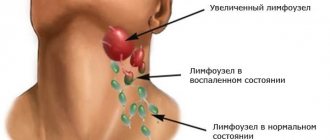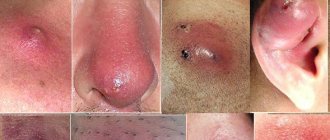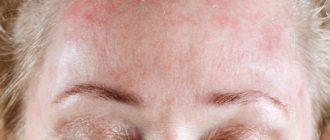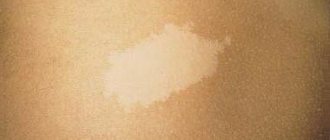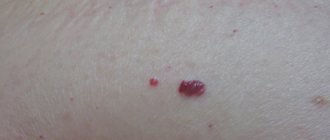A boil differs from a regular pimple in that it is much larger, very painful, and contains a lot of pus.
But quite often this pus does not have the opportunity to come out, which not only causes significant discomfort, but is also extremely dangerous.
There are several reasons why a boil may not break through and heal, each of which needs to be taken a closer look.
Reason: went deep under the skin
With the correct development of the inflammatory-purulent process, a boil core forms a few days after the appearance of the red nodule. It is then that significant pain manifests itself, because the process affects the deep layer of soft tissue.
In this case, the head of the boil begins to gradually come out, becomes large, and has a yellowish color. If this does not happen for a very long time, a person has the opportunity to observe an exceptionally large, red lump, feels pain and faces a significant increase in body temperature, which means that the following is happening in the body:
- The shaft of the boil began to develop in the wrong direction.
- The pus, instead of breaking through closer to the upper layers of the skin, went deeper.
- The contents of the boil mature in the deep layers of soft tissue and have the ability to rupture at any moment, infecting the entire body.
This structure and location of the boil is catastrophic for humans. In the normal course of the disease, the boil begins to form a purulent center 3-4 days after the appearance of the red lump, and breaks through about a week later. If a person does not observe noticeable changes within the specified time frame, he should immediately consult a doctor.
Reason: not ripe
The process of boil ripening in each individual case is a universal and unpredictable process. It all depends on the size of the boil, additional treatment measures or lack thereof, the rate of reproduction of staphylococci and factors of a similar nature. If the boil does not break out, but the person clearly sees its internal, purulent core, the reason for this delay may be the following:
- the boil has not yet fully ripened and needs to wait an additional few days;
- the purulent contents do not have the opportunity to break through the dense layer of skin, because there is still too little of it;
- the boil will continue to grow and develop.
If the boil is not fully mature, it will never break out on its own. You should not squeeze out the purulent contents, assuming that this can already be done, because the unpleasant phenomenon can occur again, having more serious consequences.
In order for the boil to ripen faster and open on its own, it must be properly treated daily. To do this, you can use antiseptic pharmaceuticals such as ethyl or salicylic alcohol, hydrogen peroxide, Vishnevsky ointment or ichthyol ointment, saline solution.
The process of ripening and rupture of the boil can be accelerated by the use of traditional medicine methods and the method of heating. It should be remembered that heating can only be used if the boil exists in a single form. If you violate this ban, the existing boils will not break through and many new ones will appear.
What to do if the boil breaks out? Treatment methods and consequences
A boil brings a lot of trouble and pain.
The cause of purulent inflammation of the hair follicle is Staphylococcus aureus, and the lack of proper treatment leads to serious consequences, so you need to know how to treat it correctly and what to do if the boil has ruptured.
In advanced cases, the problem can only be solved surgically, but to prevent this, you need knowledge about the maturation process and, of course, a timely visit to the doctor.
Stages and symptoms of boils
The entire cycle of development and maturation of boils is divided into three phases and lasts on average no more than 10 days:
- At the first stage, swelling is noticeable, the skin around the abscess is red, dense, and it is painful when touched. During the maturation stage, pus accumulates.
- Next, a purulent process develops. A rod formed by dead tissue and pus appears in the inflamed area, then it breaks through and comes out.
- The third stage is called healing. After the boil breaks out, the person feels better, and the wound gradually heals.
The duration of the stage differs for each patient. Sometimes the boil is so large that it leaves a scar.
If there are a lot of boils on the body, then this disease is called furunculosis. The most dangerous location of the purulent process is the face.
What to do if the boil breaks out
It is important to treat a boil and monitor its progress before it breaks out.
At the stage of maturation of the rod, the affected area of the skin is lubricated with Vishnevsky ointment, ichthyolka or other available and easy-to-use medicines.
In this way, you can remove bacteria, relieve swelling and redness around the boil. Thanks to special ointments and compresses, the pus will come out faster, and the patient will feel better after the abscess breaks through.
When the boil breaks out and the purulent contents come out, the resulting wound should be thoroughly treated with an antiseptic. For disinfection, hydrogen peroxide is first used, which is used to treat the tissue around the sore spot and the wound itself.
You need to rinse the affected area of skin until all the pus comes out. Before the procedure, be sure to wash your hands. Purulent discharge may continue for several more days, but after the first procedure to remove it, the person becomes much better.
After a breakthrough, you should continue to use Vishnevsky ointment or levomekol in the form of a bandage or application. Depending on the progression of the skin disease, a course of antibiotics may be required. If a person experiences severe pain due to an abscess, non-steroidal anti-inflammatory drugs are prescribed for internal use.
Consequences
The presence of a boil on the body always means the presence of an infectious process. A subcutaneous abscess is very dangerous, which may not break out, but develop into more complex forms. Uncontrolled squeezing of a boil can be harmful and even life-threatening, which can lead to sepsis and other problems.
If the boil is injured, its gradual maturation is disrupted. It is also dangerous to wait too long for a boil to break, as it can turn into an abscess.
To prevent this condition, you should seek medical help promptly. The appearance of ulcers on the neck and thighs is fraught with inflammation of the lymph nodes if an infection gets into the wound.
Squeezing often leads to furunculosis and other problems.
Which doctor should I turn to for help?
If the boil appears for the first time in a single number, you can seek help from a therapist. Treatment in this case will be simple and understandable, provided you consult a doctor in a timely manner. You should consult a dermatologist, who will provide assistance not only in mild cases. If surgery is necessary to remove the abscess, you will need the help of a surgeon.
What not to do with a boil
Often, improper care of the abscess during its maturation and breakthrough leads to the formation of scars, the wound takes a long time to heal, and in severe cases, surgery cannot be avoided. To prevent this from happening, you should follow doctors' recommendations about what you should never do.
You can't push
All doctors unanimously declare that squeezing out an abscess on your own is not only harmful, but also dangerous for the patient’s life, especially if the inflammatory process is located in the nasolabial triangle.
The blood vessels in this area are connected to the brain, therefore there is a risk of blood poisoning, meningitis and the development of purulent abscesses.
In addition, it is very easy to get an infection through an open wound on any part of the body and aggravate the situation, because at home, treating a boil is rarely correct. Do not use a needle or other improvised means to open it.
Why you can’t smear with brilliant green
Iodine, brilliant green and other antiseptic solutions that can stain the area of inflammation will not allow the doctor to determine the exact size of the abscess and other important signs. You can miss the first changes and the onset of serious complications of the disease. It is recommended to use such drugs only after a boil has broken through.
Unnecessary compresses
After a boil breaks out, it is important not to apply everything to the sore spot. A sterile bandage or gauze bandage without additional components is the best solution at this stage. All other ointments and other remedies must be prescribed by a doctor.
Harm of antibiotics
Many people decide to play it safe and take antibiotics, and do it on their own. Such a choice can seriously harm your health, disrupt the intestinal microflora and will not always 100% stop the development of the purulent process.
During the treatment of a purulent formation, it is better not to work, and you should not swim or wet the wound. It is forbidden to apply cosmetics to the boil to hide it, because this way it is very easy to introduce any infection.
The importance of continuing treatment after breakthrough
If you do not treat the boil after it breaks, you can get a relapse of the disease, and the healing process takes much longer. An important point is maintaining cleanliness.
Even after complete recovery, you should thoroughly wash your body with soap, and during treatment it is better to use antibacterial hygiene products.
If the wound was treated correctly, after a few days a clear liquid will appear from it, which means you can stop compresses with antibiotic ointment, but you need to continue to monitor the process of wound healing.
You cannot interrupt treatment, because after the pus comes out, the boil is no less dangerous than during its maturation.
A person is considered completely healthy when all the crusts come off from the sore spot, but this will only happen if the wound is properly cared for.
What antiseptics are used to draw out pus?
Products with an antiseptic effect are used on an ointment basis, which is very convenient and will help quickly heal the wound. Tetracycline ointment, levomekol, and compresses with dimexide are often used; salicylic acid also accelerates the ripening process. Ointments with ichthyol and Vishnevsky for drawing out pus are widely known, and they are also available in any pharmacy at a price affordable for everyone.
Timely treatment of a boil will help to avoid the serious consequences of a purulent process, which are common, and also to avoid surgical intervention.
Mandatory disinfection and regular compresses with special ointments after a boil breaks out will speed up the healing process and prevent subsequent relapses.
The best prevention of furunculosis is compliance with personal hygiene rules, a balanced diet and lifestyle.
about the causes of boils
Source: https://otprishchei.ru/raznovidnosti-vospalenij-na-kozhe/furunkul/chto-delat-esli-furunkul-prorvalsya/
Reason: location
Quite often you can encounter such an unpleasant situation as the location of a boil in the ear, nose, intimate area and other hard-to-reach areas. It will be especially difficult for a boil to break through if it is located inside the nose or ear. In these areas of the body, it does not have enough space to develop and mature; it can go deep under the skin, which will prevent the breakthrough of purulent contents.
If the boil is located under the stake
under the arms, under the arms or in similar, difficult areas, it will be much more difficult for it to properly mature and break through. In addition, there is a risk that a small amount of the internal contents of the boil may come out before it is fully ripe, because friction is often observed in these parts of the body.
The problem will remain uncured and will continue to develop, with even greater efficiency, but at the same time the person will be firmly convinced that the boil has not yet matured and has not broken through. Often this process lasts for several weeks or even months, and only such periods of the disease make the patient think that something is wrong.
Boil development stages
From the first symptoms of illness to recovery, the boil goes through 3 stages of development.
- The first is the formation of infiltrate. Redness appears on the skin. There is a compaction under the skin. A person pays attention to the occurrence of pain, itching, and discomfort during touching. The tissues around the seal swell, become hot, and begin to hurt very much. The general body temperature may increase - symptoms of malaise appear. Gradually, the formation increases, rising under the skin. The boil resembles a lump - it is round, does not move, and can noticeably harden. When the boil reaches its maximum size (sometimes several centimeters in diameter), a white purulent head appears in the center - the core of the abscess. Purulent masses will subsequently come out through this passage. The cone itself begins to harden under the pressure of the contents.
- The second is the purulent-necrotic stage. Develops when the boil is fully mature. Purulent masses can come out gradually in small quantities, or come out abundantly, completely emptying the capsule. After the breakthrough, a hole appears, a cavity in which the purulent capsule was previously located. In the crater, infiltrate, blood, and dead tissue remain. When this stage occurs, the symptoms weaken, the pain partially subsides, the skin stops becoming inflamed, and the swelling decreases. With a successful course of the disease, the condition moves to the next stage.
- The third stage is healing. New tissue gradually forms in place of the hole. The wound may ooze for some time. Possible hardening under the skin. A crust appears around the hole. If the boil was small in size, no trace remains of it. With deep lesions there is a risk of scarring or cicatricial formation. In some cases, a keloid scar appears in place of a previous purulent pimple. The process of complete recovery can take from several weeks to several months. It all depends on the degree of damage and methods of auxiliary therapy. The use of healing drugs accelerates regeneration and prevents the risk of residual marks.
Skin too thick
If the boil is not large in size, but most likely resembles a regular pimple in structure, but is located in an area of the body where the skin is thickened, it will be very difficult for it to break through. You won’t be able to solve this problem on your own; various pharmacy antiseptics and home remedies won’t help either.
Quite often, a problematic situation of this nature arises precisely in such cases:
- a boil formed on the spot,
where there was some kind of scar or a scar, the skin is always denser there; - a person who is faced with this problem is obese, which contributes to the thickening of the skin and the boil cannot break through;
- an inflammatory process has formed in areas of the body that are most often exposed to shaving - after constant hair removal, the skin becomes denser.
The presence of this problem and the impossibility of the boil breaking through is a reason to contact a doctor, who will most likely offer the patient surgical intervention.
How does the human factor influence this problem?
If there are many reliable and proven folk methods for treating cheria, they help many people cope with this unpleasant phenomenon. Unfortunately, this does not always happen and the person himself can harm himself using different recipes. Not all folk methods from the Internet are correct, effective and positive, and many even do more harm than good.
Frequent reasons why a boil does not ripen or open are precisely these processes:
- Incorrect use of traditional medicine, failure to comply with proportions and measures
precautions. - Using some unknown recipes that can have the opposite effect.
- Independent acquisition and use of potent pharmaceutical drugs and antibiotics.
- A person is constantly in the cold and the boil does not have the opportunity to ripen.
A person’s carelessness will be a factor in the fact that he will have to be treated for a very long time, and the process of maturation and breakthrough of the boil will become more painful than is the case in standard cases. If a person buys pharmaceutical drugs without taking into account the usual antiseptics, without the recommendation of the attending physician, he risks his own health and even life.
If the boil does not mature for a long time and does not burst through the fault of the person himself, he may encounter phenomena such as a strong increase in body temperature and an increase in the density of lymphatic fluids.
What not to do?
If boils occur, it is strictly forbidden to wash the affected area with soap. This can lead to the spread of infection to other parts of the outer covering.
If the boil does not break out on its own for a long time, it is not allowed to squeeze it out to speed up healing. Mechanical damage is dangerous, as it will provoke an extension of the maturation process and the penetration of infection.
Prohibited measures to influence the problem
If the boil does not go away for a long time, the pus cannot break through, the formation hurts too much, a person should not sit at home idly or rely solely on traditional treatment methods.
If the boil does not open, and several weeks have already passed since its appearance, the victim must do the following:
- Contact an experienced surgeon immediately.
- Follow all recommendations and instructions of the doctor, take antibiotics.
- If necessary, agree to urgent surgical intervention.
The only way to help the boil break through in 95% of such cases is surgical intervention. The process itself is not complicated and is carried out under general anesthesia. The rehabilitation period will be several days.
If the boil cannot break through and does not want to hide on its own even after ripening, you should not engage in amateur activities and perform the following actions:
- Squeeze out the pus yourself, even if your hands are treated with an antiseptic solution.
- Open the boil using nail files, nail scissors, blades and similar sharp objects.
- Pierce the contents of the boil with a needle, hairpin or something similar.
- Make warm compresses and continue to use traditional treatment methods.
The use of prohibited items and methods can lead to a person experiencing blood poisoning and putting his life in danger.
If the boil does not want to break out on its own for a long time, you should not touch it. A person must realize the seriousness of this problem and consult a doctor as quickly as possible. When the boil matures, it will be able to open on its own, and if such a process is not possible, a qualified doctor must remove the inflammatory-purulent formation under sterile conditions.
What to do if the boil bursts and pus and blood come out?
Pustular skin lesions bother patients at any age. It is not always possible for a patient to visit a doctor in a timely manner. Therefore, it is useful to know what to do if the boil breaks out.
Clinical picture and general advice
The boil breaks out on average 4-6 days of its development. The process can occur in 2 main ways:
- Natural.
- Artificial: surgical;
- by self-extrusion.
If a boil breaks out naturally, the first thing that comes out is pus. The necrotic rod is then rejected completely or partially. In the first case, an ulcer remains. When the rod is partially withdrawn, necrotic masses remain at the bottom of the formation.
The results of this situation are:
- longer healing time;
- development of complications;
- the possibility of re-forming an abscess from a boil;
- furunculosis (multiple skin lesions).
The surgery is performed by a surgeon under sterile conditions. The formation can be opened in a hospital or clinic. The indication for its implementation is a large single boil with an extensive area of necrosis.
After the incision and sanitation of the abscess, the cavity is washed with antiseptic solutions. Be sure to install drainage to remove the inflammatory fluid. This will make the healing process shorter and prevent the development of complications.
Any therapeutic effect when a boil has opened includes 3 components:
- Compliance with general rules.
- Local therapy.
- Use of systemic drugs.
Among the general prescriptions for patients with a burst abscess, the following is indicated:
- daily change of towels, pillowcases, underwear;
- avoid temperature stress in the form of overheating and hypothermia;
- reduce the ingress of water onto the affected area;
- avoid traumatic effects from clothing (friction, tugging);
- “rest” of foci of suppuration to prevent excessive skin tension (especially if boils open on the face) - absence of sudden movements, reduction of facial expressions, eating soft food;
- careful adherence to personal hygiene, especially hand washing.
Contraindicated for a burst boil:
- Combing and rubbing the affected area.
- Shaving when the boil is localized in the scalp.
- Use of fatty creams.
- If the rod is completely rejected, pulling medicinal ointments should not be applied.
- If a boil located on the cheek or temple has broken out, then it is undesirable to use temporary contact lenses due to swelling of the eyelids.
- Local warmth.
The specific treatment regimen for a opened abscess depends on:
- quantities;
- localization;
- depth of damage;
- patient's age;
- concomitant diseases.
Therefore, if you have boils, it is advisable to contact a specialist - a surgeon or dermatologist. They will select the most effective and safe therapy.
Some features of therapy
Suppuration can be located on any part of the skin, except the palms and soles. This is due to the absence of hair follicles in these areas. Single boils are more often diagnosed in the following areas:
- back of the head;
- forearm;
- small of the back;
- stomach;
- buttocks;
- lower limbs.
With such localization of the disease, if the boil bursts, the algorithm of actions comes down to 5 steps:
- Treatment with hydrogen peroxide.
- Rinsing with antiseptic solutions (Potassium permanganate, Furacilin).
- Make a tampon from the Hypertonic solution and apply it to the wound.
- Then apply anti-inflammatory and adsorbing ointments directly to the center of the formation (Syntomycin, Vishnevsky).
- Cover the top with a bandage with antibacterial ointment (Levomekol, Baneocin).
If the purulent-necrotic core is partially discharged from the boil, it is recommended to use Ichthyol for several hours. Then repeat the above described manipulations.
If the boils have burst and the necrotic core does not come off well, then after thorough treatment of the cavities, the use of proteolytic enzymes for 2-3 hours (Chymotrypsin) is indicated. They soften the formations and contribute to its faster release.
Opened suppurations located on the face are subject to more intensive treatment. System support is required. If during a breakthrough the pus does not come out completely, it is strictly forbidden to squeeze it out. After thorough treatment of the wound, prompt consultation with a doctor is indicated.
The situation when, when opening a boil, the discharge comes out with blood requires special attention. This occurs due to 2 reasons:
- damage to the wall of a superficial blood vessel when an abscess breaks through;
- involvement of adjacent arteries in the pathological process.
In the first case, the pus contains a small admixture of fresh blood. The further the focus is located from the vessel, the smaller its amount. After thorough treatment of the wound, blood is no longer detectable. This situation occurs often.
The appearance of bleeding from a boil, especially one that has burst on the face, is a bad sign. It indicates a large depth of lesion with the involvement of surrounding blood vessels.
The algorithm of actions in the event of bleeding from a burst abscess comes down to 4 points:
- thorough treatment of the wound with antiseptic and disinfectant solutions;
- use of a hemostatic sponge (cotton wool wrapped in gauze);
- applying a pressure bandage to stop bleeding;
- urgently seek medical help.
When the boil has opened with bleeding, antibacterial therapy is mandatory. Hospitalization in a hospital for 2-3 days is possible for careful observation.
What medications can help?
In the treatment of pustular skin lesions, local therapy takes a leading place. When a boil bursts, the following medications are recommended:
| Detoxification and adsorbing solutions | Hypertonic sodium chloride 0.9% and 10% |
| Alcohol solutions of aniline dyes |
|
| Disinfectant pastes |
|
| Anti-inflammatory ointment forms |
|
| Antimicrobial ointments |
|
| Proteolytic enzymes | |
| Tissue regeneration stimulators in the form of ointments |
Local therapy is carried out for any form of the disease when a boil opens, regardless of the patient’s age. Its main tasks are:
- complete cleaning of the resulting cavity from purulent-necrotic masses;
- relapse prevention;
- acceleration of healing;
- preventing the development of complications.
A big advantage of local exposure is the small number of side effects due to minimal absorption of drugs into the bloodstream. This is important when selecting therapy for children.
Systemic medications are indicated for burst boils in 4 cases:
- localized on the face, especially in the area of the nose, upper lip, temple;
- multiple lesions;
- recurrent course of the abscess;
- a pronounced decrease in the patient’s body’s defenses.
The following oral medications are used when the boil breaks out:
| Broad-spectrum antibacterial drugs |
|
| Specific immunotherapy |
|
| Immunomodulators | |
| General strengthening action | Vitamin complexes with a high content of groups A, C and B |
Only a doctor knows what effective treatment regimen to choose if the boil has broken out. The treatment period is 7-10 days. When an abscess bursts, a visit to the doctor is mandatory. He will prescribe the necessary therapy to quickly cope with the pathology without developing severe consequences and cosmetic defects. Self-medication is acceptable to alleviate the condition before consulting a specialist.
Loading…
Source: https://doloypsoriaz.ru/furunkul/lechenie-01/lopnul-furunkul.html
